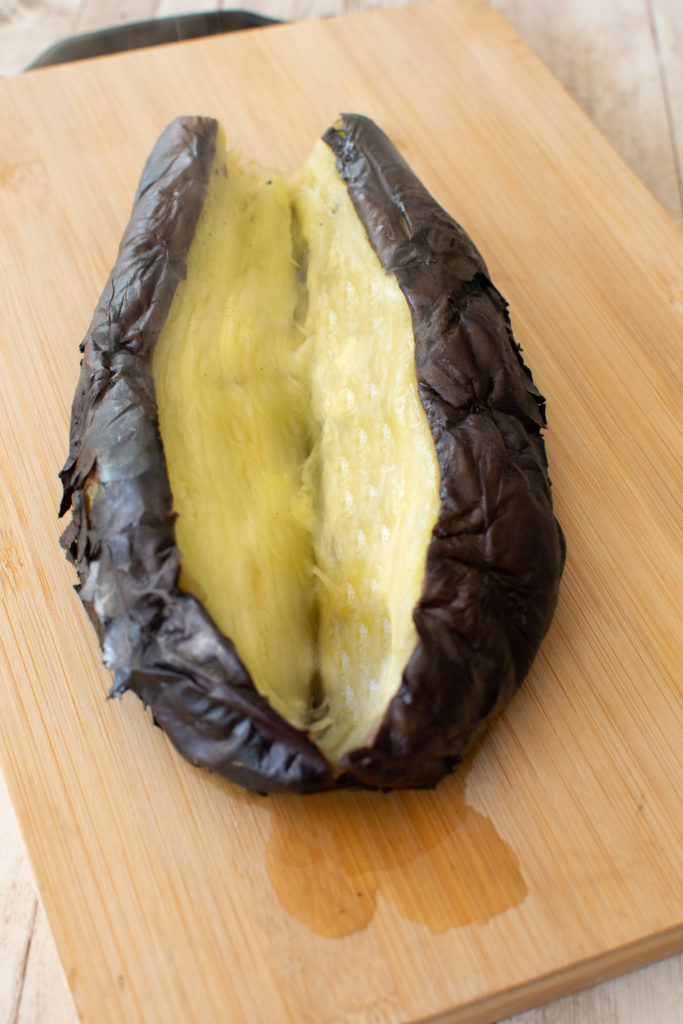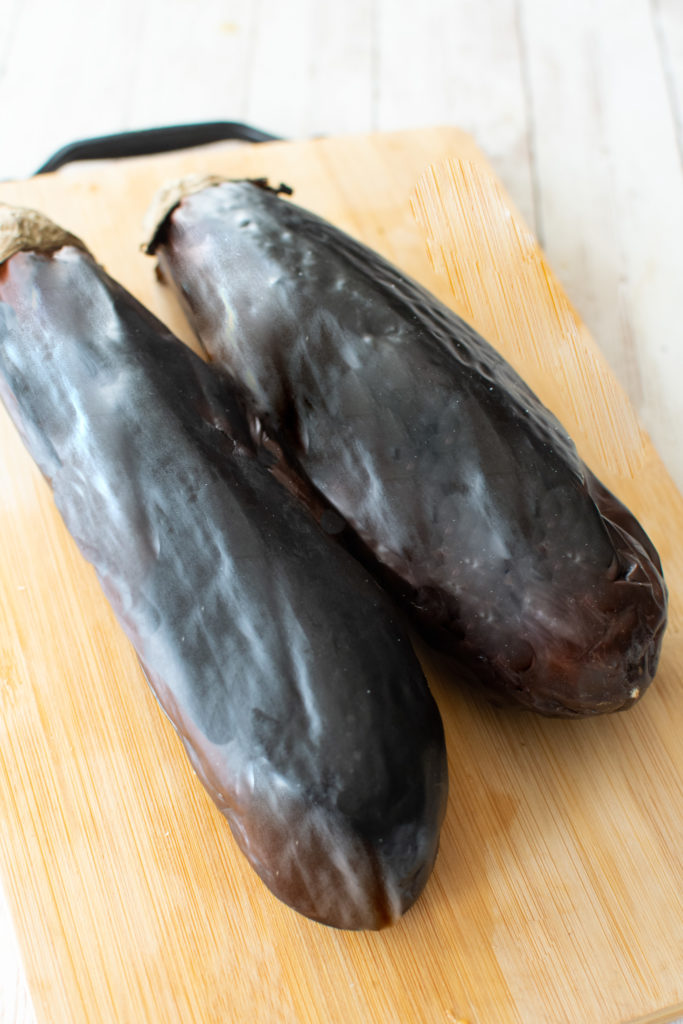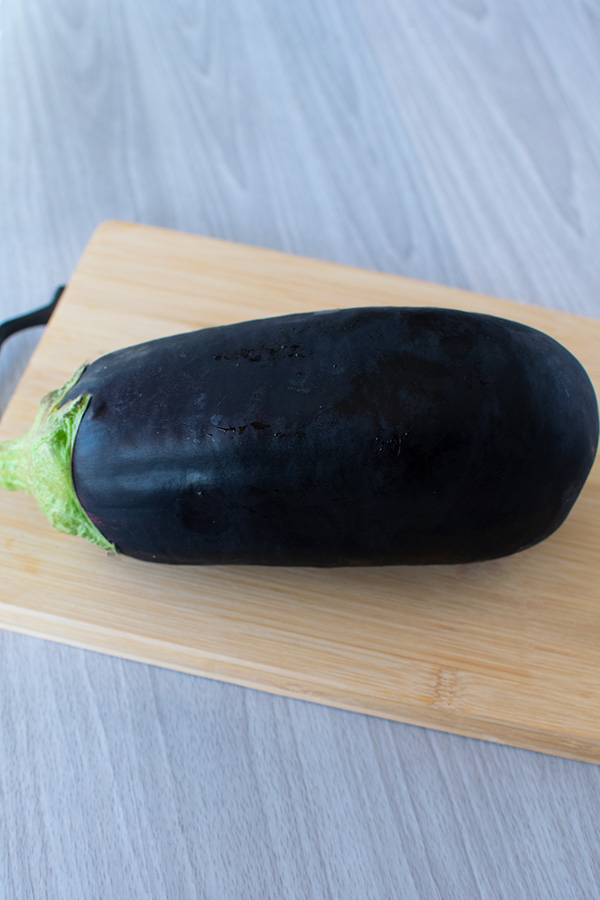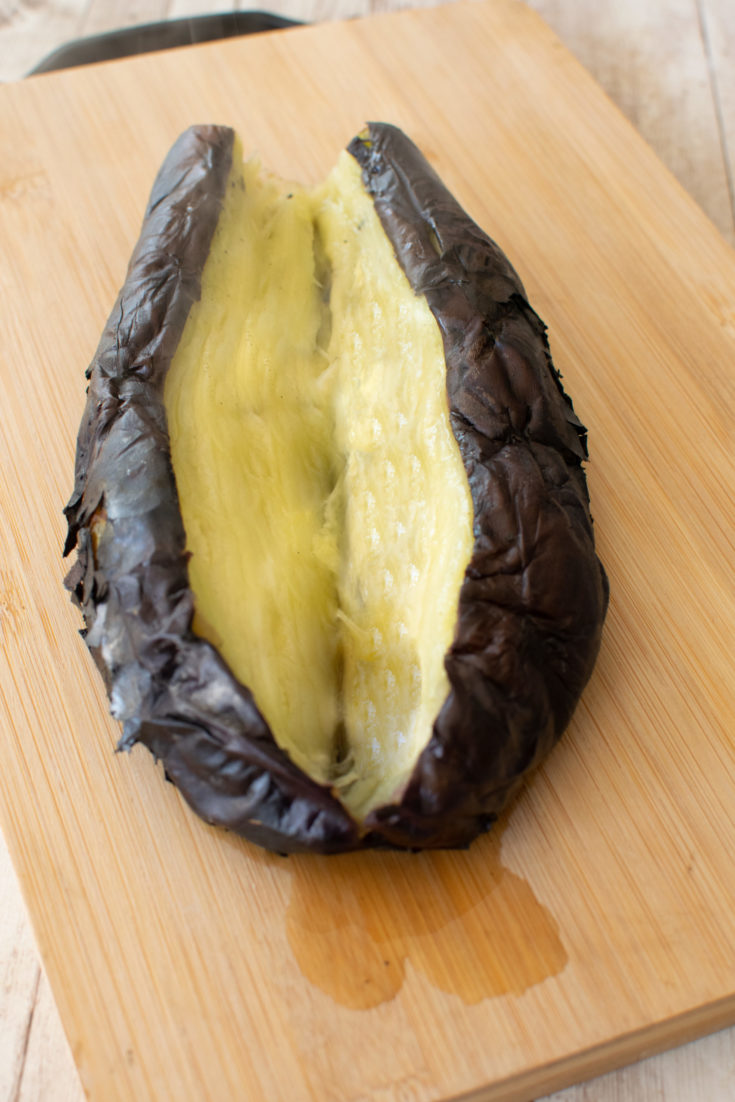Roasted Eggplant for Passover is a delicious, vegan Middle Eastern/Israeli dish. The eggplant can oven-roasted or roasted directly on an open flame.

Roasted Eggplant for Passover is a favorite dish that can be eaten any time; as a side, as a snack, as a light meal… While some people wrap potatoes in aluminum foil and place them in an oven or toss them into a fire, one can also wrap eggplant in aluminum foil and place it on a flame on your stove. That’s how Israelis do it in their homes.
Then, they will cut it open, drizzle or pour tehini on top and eat it right out of the skin…or even with the skin, which – after it has blackened – is soft and delicious when eaten together with the cooked meat of the eggplant.
Of course, tehini is not kosher for Passover, so you will need to wait until the holiday is over to eat it that way! HOWEVER, you CAN use a variety of herbs and spices to add flavor if you want to. And a lot of people top it with diced tomatoes as well!
Eggplants can be roasted in several simple ways:
1) Roast over an open flame: Poke a fork or a knife into the eggplant in several places to allow air to escape. Then, place the eggplant over a burner with open flame on your stove (cover around the burner with aluminum foil first to protect it from the eggplant, which will leak as it cooks). Some people first wrap the eggplant in aluminum foil before placing on the flame, so whichever way works for you. Turn or reposition the eggplant every 2-3 minutes as the part over the flame has blackened and has shriveled a bit, until the entire eggplant has blackened shriveled somewhat. This is the best way to prepare it (over an open flame), because of the smokey flavor it gives.
2) Roast over an electric stove: The same as the process above, but use a grill pan over the burner. It may not cooks as quickly as it does on an open flame.
3) Roast in the oven: Poke a fork or a knife into the eggplant in several places to allow air to escape. Place the eggplant on a baking tray or in a baking pan lined with aluminum foil or baking paper. Place in a oven on a high temperature (400°F – you can use a higher temperature, but check more often) and turn the eggplant every 10-15 minutes or so until the entire eggplant has blackened shriveled somewhat.
4) Broil in the oven: Poke a fork or a knife into the eggplant in several places to allow air to escape. Place the eggplant on a baking tray or in a baking pan lined with aluminum foil or baking paper. Place in a oven on broil and turn the eggplant every few minutes or so until the entire eggplant has blackened shriveled somewhat.


They are ready when you can easily slide a fork or knife through the skin and meat of the eggplant.
The skin becomes so soft that, if you want, you can eat it.
However many people just slice it open, sprinkle with tehini, or salt and/or pepper, and eat it right out of the skin.
Or you can peel off the skin or scoop out the inside and place on a plate or use it to make eggplant salad, such as this one: Israeli Eggplant Salad for Passover.
A little of my cooking background
I really wanted to title this blog “If I can make it, anyone can” because, honestly, if I can make it, anyone can.
I never really liked cooking, and when I was single, a meal for me meant grilled cheese, eggs, tuna, or something else that didn’t require effort or time.
When my kids were young, I was still able to get away with preparing only a small variety of easy meals, but the older they got, the more dishes I learned to make at their request.
Still, I insisted on keeping it simple.
Honestly, I never understood why some cooks unnecessarily complicate meals. I have seen recipes that have several ingredients that don’t really seem to add much, if anything, to the dish. So, why bother?
It has always been important to me that whoever eats at my table will have plenty to enjoy, and that includes my kids (I never agreed with the “You will eat what is served, or you won’t eat” ideology), and, because I keep it simple, I can prepare a variety of dishes in a relatively short period of time.
I have a philosophy regarding being a great cook: Prepare food according to the tastes of those who will be eating it, and they will love your cooking!
As far as I am concerned, start with the basic ingredients that make the dish what it is, adapt according to taste, and voila! You are an amazing cook!
The bottom line is that while there are certainly delicate recipes out there for specialty dishes, making delicious meals doesn’t have to be complicated or time-consuming. It’s not difficult to impress—just make sure it tastes good.
While some of the recipes on my blog are more time-consuming than others, they are all tried and true, easy-shmeezy!
Of course, one always has to consider the conditions under which they cook. Weather (humidity, heat, cold), different types of ovens, different qualities of pots, etc.—all of which can affect your cooking and baking.
Nevertheless, as I said, if I can do it, anyone can!
About recipes…
Unless an ingredient is integral to a recipe (like onions in onion soup, for example), people familiar with cooking will adjust recipes to taste. So, normally, when someone likes a little more garlic or less pepper or a little more spice or a little less salt, we adjust.
I mean, why make a dish if those who are going to eat it won’t like it, right?
The question now is how to know which recipe to choose?
Personally, I only like recipes that are uncomplicated, so I look at the ingredients and the instructions.
If I see tons of ingredients with minimal measurements (1/4 teaspoon of this, pinch of that), I automatically assume that 1) it’s a very delicate recipe or 2) the blogger added a bunch of unnecessary spices. Neither work for me.
If you are the type who likes detailed and lengthy recipes with exact cooking I applaud you, but my recipes are almost definitely not what you are looking for. I simplify anything I can.
You have to decide what works best for you.
Also, while searching for a recipe, you may have noticed that a lot of recipes are exact copies of others while other recipes have the same name, but different ingredients and they all express authenticity.
So, how can there be so many variations of authentic?
Well, for one thing, authentic doesn’t necessarily mean “original”.
For example, let’s say a recipe was created in a particular community in a country because of the availability of ingredients. Then people from that community were expelled from that country, ran for their lives, or just emigrated for a better life elsewhere.
They would, of course, bring their culture and recipes with them, including any taste adaptations that had been previously made, such as spices, vegetables, meat, or even the way to cook a dish.
Recipes were shared, more taste adaptations may have been made, and also changes may have been instituted due to the accessibility (or cost) of ingredients in the new country. For example, if there was a different variety of spices, if now meat was more or less affordable, or if a different variety of vegetable was available.
So, now after generations, you have cultural dishes with the same name (or different names in different countries), but with somewhat different ingredients and different flavors. A lot of times, a dish will have the culture name before it; Russian this, Creole that, Tunisian this, French that.
So, while a dish may not be the “original”, can we say it’s not authentic?
An example of this is Chinese food. While we may call a dish by the same name, AMERICAN Chinese food may use different vegetables. Not only that, but some American Chinese food just that – AMERICAN Chinese, not “original” Chinese.
Jewish and Middle Eastern/Mediterranean food is similar. While the main ingredient will be the same, Jews from different countries have different ways of making the same dishes. Good examples of this are breads and salads.
Another thing to note about authenticity is that sometimes bloggers write with an tone of authority that makes it seem as though they have the “right way” of making a dish.
I know one blogger who will take a two vegetable salad and add a bunch of stuff and indicate that THIS is how it is made. Or a 5 ingredient stew, add a bunch of extras and indicate that THIS is the recipe for the stew. I don’t believe that it fair to the readers.
In my opinion, this is like sharing a recipe for an omelet with someone who has never had one and including your favorite ingredients – above and beyond the egg. If you don’t tell her you make it to your personal preference, she will think it’s the “right way” to make an omelet.
Even when you do find an “authentic” recipe, passed down for generations exactly as it always was, you can be pretty certain that someone else’s family has their own “authentic” version.
That said, the recipes I post are the way that I like to make them (or rather, how my family likes that I make them). However, I mostly try to provide the basic versions of a dish with suggestions for adapting to your own taste.
Note that the above refers to cooking, not baking. Unless you really know what you are doing, I recommend sticking to the recipe unless otherwise indicated.
Food on Passover
Torah-observant Jews do not eat chametz (the fermented products of five grains: wheat, spelt, barley, oats, and rye).
In addition, Torah-observant Ashkenazi Jews do not eat kitniyot (or kitniyos as pronounced in Ashkenazi Hebrew). These include legumes, corn, rice, and similar foods that were deemed forbidden to eat by rabbis in the medieval period and are still not eaten today. Sephardi and Mizrachi Jews do not follow this tradition.
Many observant Ashkenazi Jews will not even eat the derivatives of these kitniyot, while others do (each family holds their own traditions regarding this).
Then, there are Ashkenazim who don’t eat “gebrokts” (or gebrochts).
Gebrokts (gebrochts) means “broken” in Yiddish, and in this case refers to matzo that has absorbed liquid. Not eating gebrokts is observed by many in the Hasidic Jewish community and Ashkenazim who have taken on this tradition, where they basically don’t mix anything wet with matzo.
So, things like matzo sandwiches, fried matzo, and even matzo balls are a no-no for them.
There is a joke that sums it all up:
On Passover, we should remember people who have little to eat on this holiday. They are called Ashkenazim.
Over the years, I have learned to adapt “normal” food for Passover so that my family won’t complain about boring, tasteless, or repetitive meals.
I find that having good food and variety makes the week of Passover a very pleasant experience, and I hope this recipe will help make yours just that!
Eating on the day of the seder
Jews who keep the laws of Passover do not eat matzo or any foods that contain anything from matzo (such as matzo meal or matzo cake meal) the entire day before the seder, which is in the evening.
Some people even have the custom of not eating such foods for two weeks before, beginning on Rosh Chodesh Nissan or even as far back as Purim, which is a month before.
Kosher for Passover Pantry Essentials (Suggestion)
As I learned to prepare more and more recipes for Passover, I also learned which basics and seasonings are good to have on hand to have the ability to make a dish on short notice—especially during the holiday—and not have to run out to the store or borrow from a neighbor.
While I will admit that I am not always prepared when one of my kids will ask for eggplant parmesan or something at the drop of a hat (which they have done), I dislike having to postpone making something just because the ingredients needed to make a reasonable meal were not readily available.
So, I maintain a selection of what I consider “kosher for Passover pantry essentials” in my refrigerator and on my shelves during the week of Passover (some of the dry goods I keep from year to year, stored well).
While, of course, most of the essentials will not be needed just for any one recipe, at least some of them are needed for most recipes, and you would be surprised how many recipes can be made just with this list. So, if you make sure to have whatever you use regularly on hand, it can really save you time and effort.
Everyone has their favorite recipes, preferred seasoning, and just whatever they like to use to cook. Your own list should certainly reflect your own cooking tastes and style. Just make sure that everything is Kosher for Passover (or KLP—Kasher L’Pesach, in Hebrew) and if you are Ashkenazi, that list will be shorter than if you are not.
Make sure to check with a qualified rabbi if you have any questions.
The following is a pretty comprehensive list of what you can choose from to keep on hand. I keep quite a bit of it.
Utensils:
- Measuring cups for liquid
- Measuring cups for solids (flour, sugar, etc.)
- Measuring spoons
- Mixing bowls
- Kitchen scale
NOTE: When using measuring cups and spoons, make sure that the measurements are comparable to one another (example: that 4 tablespoons equals 1/4 of your measuring cup). You’d be surprised to know that not all measuring cups are the same, and this can throw your measurements off.
Seasoning and flavoring:
- salt
- ground black or white pepper
- granulated garlic or garlic powder
- onion powder
- ground cinnamon
- sugar (granulated)
- brown sugar
- chicken consommé powder
- onion soup mix
- various herbs
- additional spices to adapt taste to preference
Misc:
- oil / margarine / butter / cooking spray
- potato starch as a thickening agent
- baking powder
- matzo cake meal (matzo meal, but ground into a powder)
- condiments, such as ketchup and barbecue sauce
- tomato sauce/tomato paste/canned tomatoes—diced or crushed/pasta sauce
- milk substitute (neutral flavor)
We always have eggs in the fridge and onions and potatoes on our shelves (if we were not Ashkenazi, I would certainly keep rice as well).
In addition, having fresh vegetables , such as carrots, celery, bell peppers (red, green, etc), tomatoes (if you don’t want to use canned), etc. can be very useful when putting together a quick but delicious meal.
It’s also a good idea to have some ground meat or chicken (breast, ground, or in parts) in the freezer for anyone who likes meat dishes in a snap.
Why are these pantry essentials beneficial to have on hand?
Personally, having the above ingredients in my kitchen is very advantageous, as I make a variety of dishes and use most of the items on the list regularly.
Whether or not buying a bunch of herbs, spices, etc., before you know what you are going to make for the week is workable for you depends on your own personal preference.
Of course, the more you cook and the more varied your recipes, the more you will use, and the more you will need.
If you plan your meals ahead for the week, you will be prepared with whatever else you might need that you wouldn’t even normally keep in your Passover pantry.
If you do decide to keep them over from year to year, I would only do so if they can be sealed well (or better yet, stored in the freezer), because not only can weather have an effect on some of the spices and on the chicken consommé powder, but you will be surprised to know just how clever moths are at getting into sealed bags and how hot red pepper powder can attract little black bugs – YUCK!
A little about eggplants
The eggplant is native to India and Asia, where it can be found growing wild, and it is believed that eggplants were brought to Europe sometime during the 7th or 8th century.
Australians and Americans call the vegetable eggplant, while in England it is called an aubergine, from the French word for this vegetable.
Because of its meaty texture, eggplant is used instead of meat in some vegetarian versions of meat recipes.
While there are a variety of types of eggplants, the one for this recipe is the large, egg-shaped (or teardrop-shaped), blackish-purple one with the meaty inside.

Eggplants have health benefits, as they contain antioxidants like vitamins A and C, which help protect your cells against damage, and are low in calories.
About cooking eggplant
Eggplants can be roasted, baked, steamed, deep-fried, or sautéed.
Before cooking an eggplant, cut off the top part where the green is (called a calyx). The bottom tip should also be removed, but this is not imperative. The skin is perfectly fine to eat, but it must be cooked well. Otherwise it may come out chewy.
This recipe can use either peeled eggplants or eggplants with the skin (having the skin on will not ruin the recipe).
Eggplant is naturally a little bitter. If you find that to be the case, you can draw out the bitterness by sprinkling it with salt and letting it sit awhile. If you are using slices or pieces, slightly salt after cutting. I have personally never found this to be a problem when cooking with eggplants
Using salt before cooking can help prevent the eggplant from absorbing too much oil and becoming greasy if using oil with the eggplant recipe (I normally just pat the pieces with a paper towel if need be).
If you do use salt, MAKE SURE to rinse it off before cooking the eggplant, or the salt will become a part of your dish!
Personally, I have never salted my eggplants before using them (and I have used eggplants in two countries) and have never had any problem with bitterness, but if you have any concern, please do.
If a recipe calls for frying, but you prefer not to do so because of the calories the oil will add to the recipe, you can spray with cooking oil and bake instead.
Roasted Eggplant for Passover

Delicious roasted eggplant, dairy free, vegetarian, and kosher for Passover.
Ingredients
- 2 medium eggplants
- salt, pepper, other spices, herbs, etc. (kosher for Passover), as desired for flavoring
Instructions
- Cut off the calyx (green top) of the eggplant.
- Roast the eggplants by placing them over an open flame and turning them as each side blackens (for more ways to roast see content in post) *
- Cut open the eggplant.
- Serve alone, with salt and pepper, with diced tomatoes, with fresh herbs, or anything you like.
Notes
* You may want to cover the area under the burner if you do this on the stove in case it leaks or you can wrap it in foil beforehand. If using an electric burner, wrap eggplant before placing on burners.
Nutrition Information:
Yield:
4Serving Size:
1Amount Per Serving: Calories: 99Total Fat: 1gSaturated Fat: 0gTrans Fat: 0gUnsaturated Fat: 0gCholesterol: 0mgSodium: 3mgCarbohydrates: 25gFiber: 7gSugar: 9gProtein: 2g